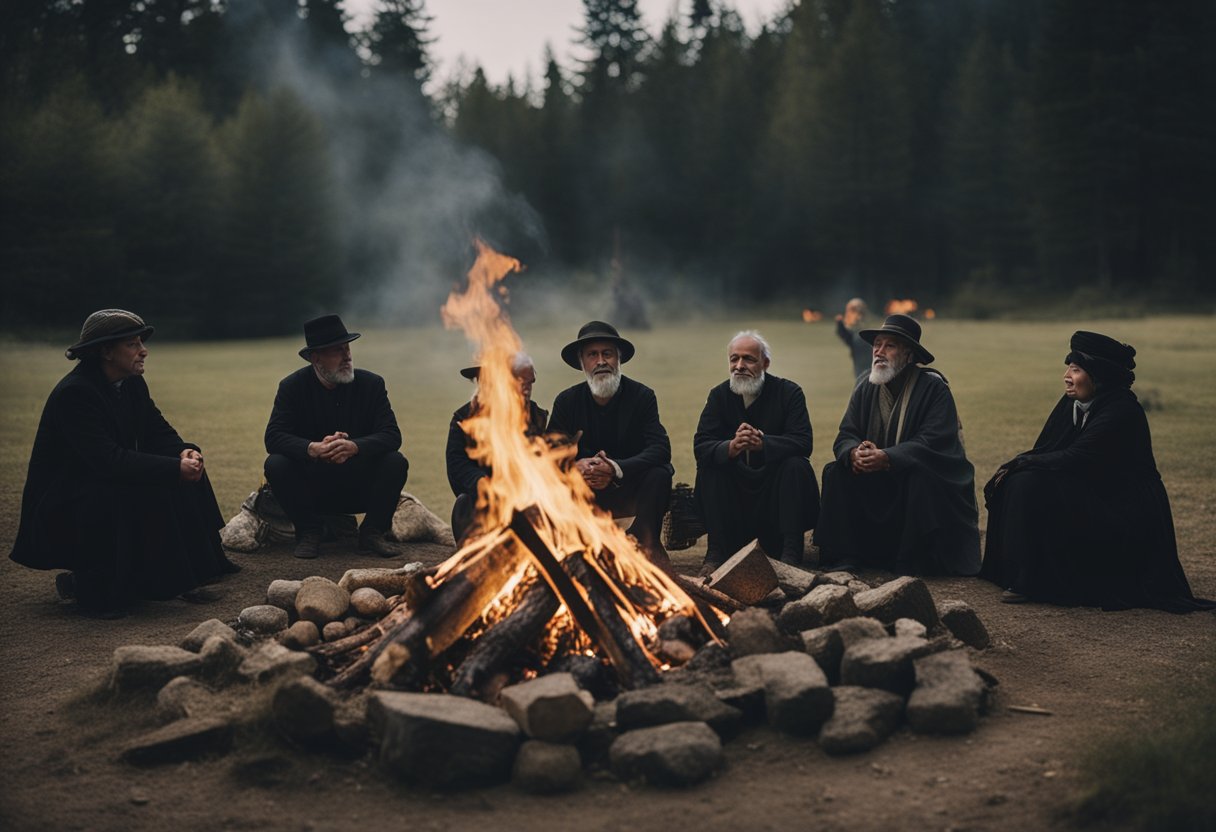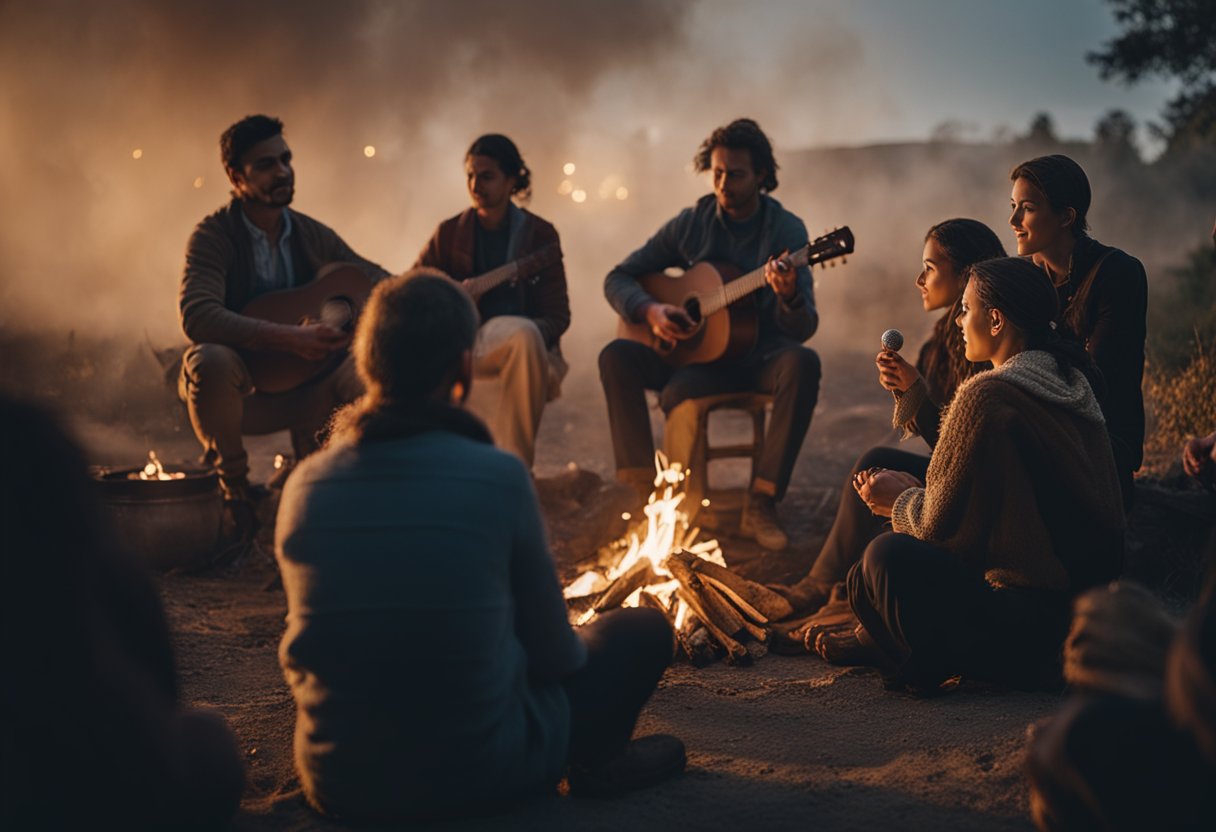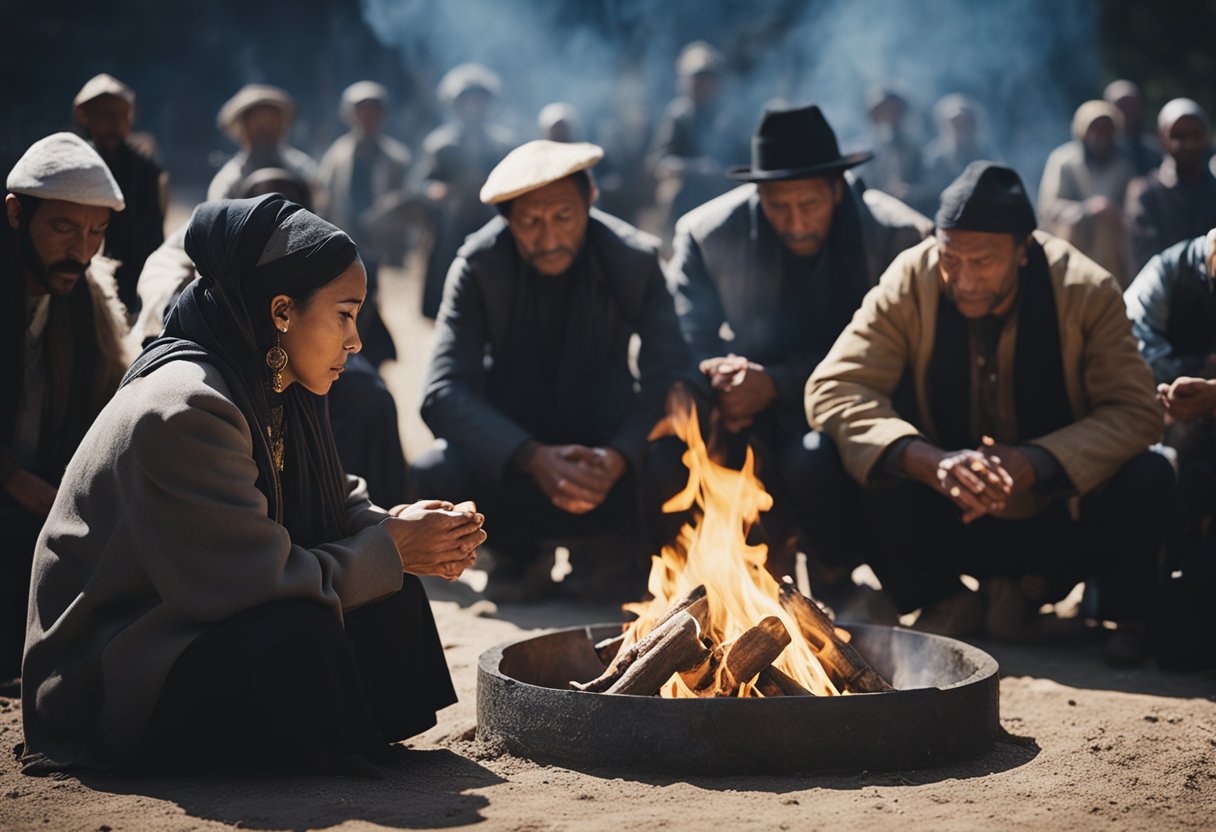The Tradition of Keening and its Cultural Parallels: A Global Perspective on Mourning Practices

Updated On: April 24, 2024 by Maha Yassin
Keening, a vocal tradition of lamentation for the dead, has been an integral part of the Gaelic Celtic cultural fabric, widely recognized in Ireland and parts of Scotland. This intricate mourning tradition finds its roots deeply embedded within the communal expressions of grief, where the keening women, often professional mourners, would perform at wakes or gravesides. These laments are not just outpourings of sorrow but are laden with historical, social, and religious nuances that speak volumes of the Celtic way of coming to terms with loss.
This practice showcases many expressive forms, from the poignant recitations of the deceased’s life to symbolic gestures of separation, underpinning the cultural significance of connecting the living with those who have passed. The keen effectively honours the departed soul, acting as a conduit between two worlds through its narrative elements and distinctive vocal techniques. Whilst keening has largely declined as a common practice, its resonance persists through the arts and the collective memory of communities, inviting a modern resurgence that seeks to understand and reclaim these poignant cultural heritages.
The Historical Roots of the Tradition of Keening

This section explores the ancient origins of keening and its manifestations across different cultures, providing a rich historical backdrop to this poignant practice.
Irish Keening Origins
Keening, or ‘Caoineadh’ in Gaelic, represents a cornerstone of Irish mourning traditions. This vocal lament, typically performed by women, has roots deeply embedded in Ireland’s past, distilled from centuries of Celtic heritage. During these laments, keeners were known to wail and sing in honour of the deceased, often in a highly improvised manner that could include reciting the person’s life and virtues.
Historically, the earliest accounts of keening in Ireland can be traced to the Middle Ages, with notable references by Giraldus Cambrensis, a Welsh chronicler who observed these practices during his travels. Keenings were not solely expressions of grief; they were a pivotal aspect of Irish funerary customs, linking the community in a collective remembrance.
Keening in Global Contexts
While keening is most commonly associated with Ireland and the Gaelic tradition, similar practices have been noted across various global cultures, signalling a universal response to loss. Egyptian rituals, dating back to the Pyramid Texts of 2600 BCE, involve professional mourning by female mourners or priests. This form of lamentation is echoed in various traditions from the Middle East, Africa, and even Asia.
These customs often transcended mere expressions of sorrow, embodying spiritual or religious dimensions within the context of their respective societies. For instance, keening could be perceived as assisting the soul’s journey to the afterlife—a tradition remarkably consistent with the ancient Egyptian belief in vocal lamentations guiding spirits to their rightful place in the realms beyond.
Whether in Ireland or across different continents, Keening retains its essence as a raw human expression employed since ancient times. From a pagan practice to a rite woven into the fabric of Christian ceremonies, it has remained a touchstone of cultural identity and a testament to the universal experience of human grief.
Cultural Significance and Variations
Our exploration delves into the cultural significance of keening within Irish traditions and its parallels in mourning rituals across the globe.
Significance in Irish Culture
In Irish culture, keening, known as Caoineadh, is a poignant expression of grief and one of the essential elements of a traditional Irish funeral. The practice involves vocal lamentation and is often performed by women, called bean chains, who lead the mourning process with heartfelt cries, wails, and song. This profound ritual is deeply interwoven with the Irish heritage and reflects the community’s collective journey through mourning and remembrance at wakes or by the graveside.
Global Parallels of Mourning Rituals
Worldwide, various cultures share a common thread of vocal expressions of sorrow, mirroring the Irish tradition of keening. In Wales and Scotland, similar practices are found, each with unique characteristics reflecting their interpretations of communal grieving. Grief has given rise to myriad funeral rituals, from the Roman Catholic Church’s respectful requiems to the distinct customs embraced by different cultures. These acts of mourning serve not just as a farewell to the departed but also as a communal acknowledgment of the universal experience of death.
The Role of Religion in Keening
Keening – the Gaelic tradition of vocal lament for the dead – intertwines closely with pre-Christian practices and the Catholic faith, reflecting a tapestry of spiritual beliefs that have shaped its expression.
Catholic Church’s Influence
The Catholic Church has played a crucial role in the evolution of keening. In the Gaelic Celtic tradition, as it is performed within a Catholic context, the ritualised wailing or crying that characterises keening often aligns with the Church’s liturgical practices and mourning rituals, emphasising a community’s grief and offering a form of collective catharsis during funerals. While initially outside official Church liturgy, the Church’s influence became more pronounced as it sought to guide such expressions within the bounds of Christian doctrine.
Keening in Pagan Practices
In contrast to the structured approach of the Roman Catholic Church, keening is thought to find its roots in ancient pagan practices. The druid figures of pre-Christian Ireland exemplify the tradition’s pagan origins, where keening may have been employed as a form of communication with the spirit world. This pagan legacy emphasises the connection between the mourner, the deceased, and the realm beyond, serving as a farewell and a spiritual guide for the journey after death.
Narrative and Lyrical Elements

In exploring the tradition of keening, we delve into its core components: the narrative weave and the lyrical expression. These elements are pivotal in conveying the blend of sorrow and solace inherent to this form.
Structure and Diction of Keening Songs
The structure of keening songs often encapsulates a free-flowing melody underpinned by a framework of repetition. The lyrics embody a lament for the children and others passed, serving as a form of eulogy. The diction is characterised by a poignant rawness that captures the gravity of grief yet honours the deceased’s virtues. To illustrate, keening might feature a refrain that echoes the release of sorrow, framing the keener as both mourner and bard.
Motifs and Themes
Keening songs are rife with recurring motifs that encapsulate life’s duality of virtues and vices. Themes focus on the human condition the pain of loss, and often include a plea for remembrance. Among these motifs are elements that hint at nature’s cycles, signifying that from death springs new life. These lyrical components interact to craft a powerful narrative, delivering comfort and catharsis within the embrace of communal mourning.
Performance and Techniques
In this section, we will explore the intricate aspects of keening, uncovering the subtleties of performance and the nuances of the various techniques employed.
The Art of Keening Performance
Keening, or Caoineadh, has been integral to Irish and Scottish funerary traditions. The performance is led by Bean Chaointe, a woman who laments the deceased through a structured yet highly emotional vocal expression. The Bean Chaointe drew upon the energy of the gathering, encapsulating the collective grief through her intense performance, often at the wake or graveside. This role was seen as a bridge between the living and the spirit world, guiding the deceased on their journey beyond.
Techniques and Improvisation
The techniques involved in keening strike a balance between pre-composed melodic laments and spontaneous improvisation. The keener would chant in a way that might start with tuneful singing and then transition into cacophonous wailing – a raw display of sorrow. Improvisation played a significant role as the Bean Chaointe wove personal elements of the deceased’s life into the lament. The sound could be haunting, reminiscent of the banshee’s mythical wail, serving as an outlet for grief and a poignant tribute to the person who passed.
Keening and the Arts
Exploring the intricate connections between keening and various art forms, we uncover rich literary depictions and musical integrations that showcase this tradition’s enduring influence.
Literary Depictions
The practice of keening has found its way into literature, most notably in the works of John Millington Synge. On his travels to the Aran Islands, Synge encountered keening first-hand, an experience which profoundly influenced his writing. His plays often reflect the raw emotional expression of this vocal lament, capturing the poignant resonance of the keener’s cry within his narratives. In “Riders to the Sea,” we observe characters rendered in deep mourning, their grief echoing the keening tradition, evoking the same heartfelt sorrow that keening aims to express.
Musical Integration
Keening has been preserved in the literary realm and through its integration into music. Traditional songs of Aran often embody the same mournful quality found in keening, translated through melodic structure. The harp, with its sombre and ethereal tones, can encapsulate the essence of a dirge, resembling the keening sound in its most profound musical form. Jim Wilts, an artist who delved into the historical aspects of Celtic music, produced compositions which intertwine the emotive power of keening with harmonic progressions, thus introducing this lamenting practice to modern auditory experiences.
The Science of Grief and Keening
Keening, traditionally an audible expression of grief, integrates profound emotional responses with cultural practices. We will examine the scientific lens under which keening is understood, especially focusing on its psychological and anthropological dimensions.
Psychological Aspects
In the realm of psychology, keening serves as a powerful conduit for the expression of grief. When we mourn, the act of crying becomes a personal release and a communal signal, allowing others to understand and empathise with our sorrow. Psychological studies suggest that vocalising grief through keening can provide therapeutic benefits, as it allows the bereaved to actively process their loss. A linguistic anthropologist might add that the language used in keens, often poetic and symbolic, contributes to the verbal articulation of complex emotions, helping individuals and communities to navigate through the stages of grief.
Anthropological Perspectives
From an anthropological standpoint, keening can be viewed as a cultural ritual that reinforces social bonds during mourning. Rituals around death, such as keening, serve a vital function across societies, providing structured means for communities to express collective grief. Such expressions of mourning are often led by a psychopomp, a guide to assist the souls of the departed, which is a concept found in various cultures. This suggests a parallel in the human need for ritualised forms of addressing loss. Our understanding of these practices has been deepened through mediums like the RTÉ radio program, which discuss the decline of these rituals and the cultural implications thereof. The cessation of keening in many societies is indicative of broader shifts in attitudes towards death, as the insights of anthropologists and folklorists reveal.
Modern Resurgence of Keening
In light of contemporary interest, we are witnessing a resurgence of keening, a traditional form of vocal lament for the dead. This revival honours past customs and adapts them to modern contexts.
Revival of Traditional Keening
In some parts of Ireland, such as Barra and Carna, there’s a concerted effort to preserve authentic keening songs. These songs, steeped in the Gaelic tradition, are integral to the historical fabric of mourning and remembrance in Irish culture. The revival has seen enthusiasts and scholars collaborate to ensure the transmission of these poignant musical expressions to future generations. Scottish folklorist Margaret Bennett has been particularly notable in her contributions to studying and perpetuating keening and other Celtic mourning traditions.
Contemporary Practices and Challenges
The practice of keening today faces the challenge of remaining true to its traditional roots while adapting to contemporary mourning customs. Our modern interpretation of these rituals involves a nuanced approach — how can we maintain the authentic essence of keening within today’s vastly different societal norms? The challenge lies in navigating the intricacies of this tradition within a culture that often favours less overt expressions of grief. Despite these hurdles, keening continues to find its place in modern funerary practices, resonating with those seeking a deep, historical connection to past rituals.
Archival and Ethnographic Work

To understand the tradition of keening, we examine archival documents and employ ethnographic methods to uncover rich cultural narratives.
Documenting Keening Traditions
Archive research unveils that the practice of keening over the dead is deeply embedded in Irish and Gaelic customs. Eugene O’Curry, one of the 19th century’s prominent Irish scholars, meticulously recorded these lamentation traditions. His works serve as a vital resource for historical context. Within archives, recounts of figures like Cu Chulainn and his interactions with the wailing figure of Aoife highlight Keening’s presence in Gaelic legend.
Ethnographic Insights
Ethnography, through active engagement with cultural practices, is essential in understanding the lived experience of keening. Sidney Robertson Cowell’s audio recordings have captured the authentic sound and emotion of the ‘ban chaointe,’ or keening woman, in the 20th century. These fieldworks offer a contemporary perspective on the practice, allowing us to observe its transformations and application in modern settings.
Comparative Analysis of Mourning Rituals
In this section, we explore how mourning rituals vary across cultures, focusing on the role of keening and its parallels in other traditions.
Cross-Cultural Examination
Mourning is a universal experience, although the rituals that express grief differ globally. For example, the Irish tradition of keening, a form of vocal lamentation for the dead, shares similarities with practices elsewhere. Keening traditionally involves wailing and evocative words, often by a professional keener, to express the communal sorrow at a wake. This practice is not confined to Ireland; variations can be seen in cultures that border the sea to those nestled in deserts. In many cultures, tears and sobbing go hand in hand with these vocal expressions, symbolising the journey from the physical world to the other world.
Keening and Other Mourning Songs
As observed in Irish culture, the act of keening parallels the toning death practices of the Tibetan Buddhist tradition, where the recitation of mantras helps guide the deceased’s soul. Similarly, the Gol of Iran is a form of mourning song that ranges from lamentation to a more melodic reflection of loss. It’s remarkable how mourning songs create a bridge across different cultures – each adapting to their spiritual beliefs and societal frameworks surrounding death practice. Whether by the sea in Ireland or in the valleys of the Middle East, these songs serve a dual purpose: honouring the departed and providing solace to the living.
Conclusion

In our exploration of keening, we have observed its deep-seated place within Irish and Scottish cultures. As a poignant form of lament, keening is intrinsically linked to the sea of emotions experienced during funeral rites. It provides a vocal outlet for mourners, transcending mere crying through its blend of wailing, song, and cry. The practice, a raw expression of grief, integrates the community in a shared loss experience.
The tradition of keening, with its roots in Gaelic Celtic culture, showcases the profound ways in which different societies find a voice for their sorrows. It has found echoes in various cultures worldwide, where the mourning of the deceased is accompanied by similar expressions of collective grief. Whether through heartfelt wailing or sombre processions, the essential purpose remains: to honour the departed and to aid the living in navigating their bereavement.
As our understanding of such ancient customs grows, we gain a richer appreciation for the diverse tapestries of global traditions. Looking across cultures, we uncover the universal threads that bind us in our life and death experiences, joy and sorrow. As a song of mourning, Keening is a testament to the shared human condition and our enduring need to express and process loss together.
Frequently Asked Questions

In this section, we aim to answer some of the most common queries regarding the ancient practice of keening and its parallels across different cultures.
What constitutes the practice of lamentation during mourning across different cultures?
Lamentation in mourning is a heartfelt expression of grief, often characterised by weeping, wailing, or singing. Across various cultures, these rituals serve as a cathartic passage for the bereaved, with practices tailored to their traditions and beliefs. For instance, keening in Ireland and Scotland is known for its poignant vocal laments, typically performed by women.
In what ways has the expression of grief through vocal lamentations been historically significant?
Historically, vocal lamentations such as keening were more than just expressions of grief; they were integral to communal mourning and heritage. These practices affirmed shared values and relationships within the community, creating a space for collective remembrance and emotional release.
Why were practices akin to keening prohibited in certain societies?
Keening and similar mourning expressions were sometimes prohibited due to their perceived clash with prevailing religious or cultural norms. The Catholic Church’s opposition to keening, citing its pagan roots, led to a gradual decline of the tradition in Ireland during the mid-20th century.
How do contemporary grief rituals compare to the ancient tradition of keening?
Contemporary grief rituals vary widely but often lack the communal and performative aspects of keening. Modern societies may prefer private or less demonstrative expressions of grief, although public memorials and digital media for sharing remembrances can reflect similar collective needs.
Can you provide examples of mourning traditions similar to keening in various parts of the world?
Similar to the practice of Gaelic keening, many cultures have their mourning traditions. For example, the ‘narr’ or wailing women in the Middle East, the traditional Mexican ‘lloronas’, and the Eastern European lamenters who perform sorrowful songs to express communal grief.
How is the mourning ritual of keening reflected in modern artistic expressions?
Keening has influenced modern artistic expressions, with elements found in contemporary music, poetry, and theatre. Artists often draw on the emotive power of lament traditions to explore themes of loss and mourning, delivering performances that resonate with the depth and intensity of the original keening.






